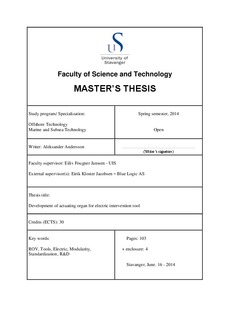| dc.contributor.author | Andersson, Aleksander | |
| dc.date.accessioned | 2014-09-15T07:24:59Z | |
| dc.date.available | 2014-09-15T07:24:59Z | |
| dc.date.issued | 2014-07-01 | |
| dc.identifier.uri | http://hdl.handle.net/11250/219673 | |
| dc.description | Master's thesis in Offshore technology | nb_NO |
| dc.description.abstract | This thesis describes the initial steps towards development of a modularized all-electric toolbox, to use during ROV intervention. Based on a vision of future subsea systems, which will rely on electrification and standardization. Inspired by standardized interfaces and interchangeability in tool kits used on land, the objective has been to research the possibility of implementing such concepts into the offshore industry.
The primary objective of this thesis was to create an understanding of ROV systems and their capabilities. The secondary objective of this thesis was to expand our understanding of relevant markets, and the services involved in these. What kind of tools are necessary to complete the given tasks? What characteristics are mandatory of an ROV to operate relevant tools in a safe and efficient manner? These questions determine what market segments are favorable and should be focused on, and thereby which tools are relevant. The third objective was to analyze the chosen tools to determine preferable properties towards electrification and modularization. The fourth objective is to determine what tools are best suited to proceed into concept and design evaluations. The properties of the selected tools are then reviewed, where necessities related to power input and outputs are established. Electric actuator solutions are then analyzed to find viable candidates within the suggested electric motor types. Several motors containing viable qualities where found. The qualities and restrictions that one must comply with during design and operation where adhered to, following these guidelines the best tooling solutions where sought out.
These objectives culminate into a goal of making it possible to enter the ROV market with limited experience, by learning the basics of the ROV business and thereby gaining insight into this trade. Based on the knowledge gained in every step of the process, datasheets containing recommended properties for four electric actuators are presented. These are capable of performing the criterions set for tooling actuators. Development processes might now proceed with the suggested candidates as the basis for further research. | nb_NO |
| dc.language.iso | eng | nb_NO |
| dc.publisher | University of Stavanger, Norway | nb_NO |
| dc.relation.ispartofseries | Masteroppgave/UIS-TN-IKM/2014; | |
| dc.rights | Attribution 3.0 Norway | * |
| dc.rights.uri | http://creativecommons.org/licenses/by/3.0/no/ | * |
| dc.subject | offshore teknologi | nb_NO |
| dc.subject | undervannsteknologi | nb_NO |
| dc.subject | ROV | nb_NO |
| dc.subject | modularity | nb_NO |
| dc.title | Development of actuating organ for electric intervention tool | nb_NO |
| dc.type | Master thesis | nb_NO |
| dc.subject.nsi | VDP::Technology: 500::Marine technology: 580::Offshore technology: 581 | nb_NO |

